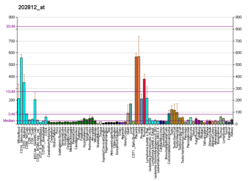Acid alpha-glucosidase, also called acid maltase, [5] is an enzyme that helps to break down glycogen in the lysosome. It is functionally similar to glycogen debranching enzyme, but is on a different chromosome, processed differently by the cell and is located in the lysosome rather than the cytosol. [6] In humans, it is encoded by the GAA gene. [5] Errors in this gene cause glycogen storage disease type II (Pompe disease).




